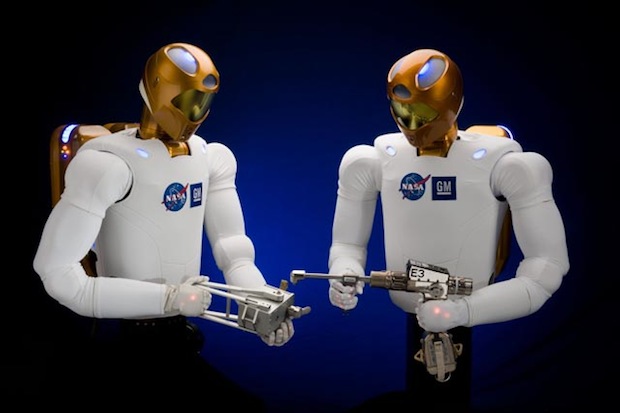
Two fascinating projects from struggling Detroit behemoth GM (and neither of the connected to the Volt): The first, a collaboration with NASA to build a next-gen robot suited both to car factories and space stations; the second, a concept for a new type of supplementary engine that would transform a car's waste heat into usable energy. Whoa.
Robonaut 2 represents a sequel to a NASA/DARPA project from 10 years ago, and was begun three years ago. In both cases, the idea was to create humanoid robots that will work alongside humans on earth and in space. The difference now is that advances in robotics now make it possible to create robots with far more dexterity--and thus able to take on more work, and adapt to more situations. Moreover, a robot could perform tasks either too tedious or straining for a human worker to do for a long period of time. Watch this video showing some amazing hand movement in the robot:
The second innovation is aimed at scavenging a car's wasted energy--which is an enormous problem: Just 30% of the gas burned by a car goes to actually propelling it. The rest is lost as waste heat, through the tail pipe and elsewhere.
The solution that GM is working on involves shape-memory alloy, a type of metal that can be shaped when cool but returns to its original shape when heated. The idea is that stringing some SMA between cool and hot elements, it'll cycle through them like a miniature drive belt. As Popular Mechanics explains:
Imagine a pack of cigars wrapped around the exhaust pipe, and you have a good idea of what the proposed generator will look like. The "cigars" are actually tubular pulleys arranged in two sets. The hot set is next to the pipe, while the cold one is offset and cooled by fresh air. The SMA wire coils around the pulleys. As the material expands and contracts, it causes the pulleys to spin, which drives a generator. GM is working with California-based Dynalloy, a company that recently developed a process to produce a nickel-titanium SMA capable of repeating millions of heat/cool cycles. "Now we can get the material in large quantities and with predictable shape-changing characteristics," Aase says.
The tail-pipe generator would save fuel by powering the cars electronics, and it could be applicable almost anywhere there's waste heat--from smokestacks to furnaces. GM expects to have a prototype ready later this year.
[Via Smarter Planet and Popular Mechanics]
Source : Fast Company, 4/02/10
Aucun commentaire:
Enregistrer un commentaire